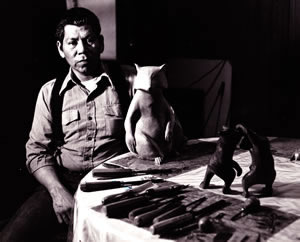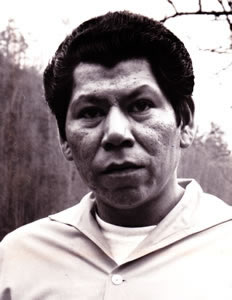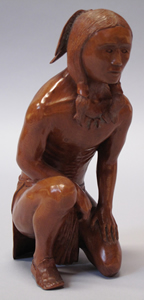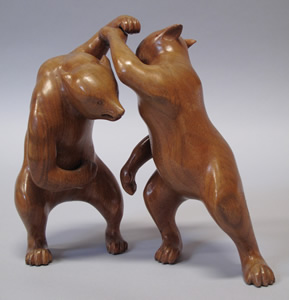People: Gilbert Crowe
Gilbert Crowe (1938-2005) was born and raised in the Big Y community of the Qualla Boundary along Wright’s Creek. He remembered being “intrigued with wood” since he was ten years old while watching his father, Albert Crowe, make bows and arrows, blowguns, and ball sticks. At that time, his main opportunity to handle wood came as he cut sticks for his family’s wood stove. “I had fantasies about what I could do with wood. The best I can remember, I made little animals out of sap knots on trees.” Inspired by nature, he recalled that even as a child, “I could look at an old laurel root and see a cat or a mountain lion.”
Crowe’s childhood imagination served him well when he attended school. “When I got to high school and started taking carving lessons under G. B. Chiltoskey, I really got excited about having a talent for this art.” Crowe was fortunate to be able to study with two of Cherokee’s most accomplished sculptors, Goingback Chiltoskey and Amanda Crowe. Both taught high school in Cherokee during Gilbert Crowe’s formative years. After leaving school, he continued to study with Amanda Crowe.

Gilbert Crowe with carvings and carving tools. On the table in front him are a pair of fighting bears.
Even as a beginner, Gilbert Crowe was interested in complex sculptural forms, rather than the small animal figurines that were made as souvenirs. “When Amanda Crowe began teaching, she encouraged me to carve large sculptures. I was the first in her class to make a big piece, a dancing bear standing on one foot with his leg up in the air.” Gilbert Crowe’s ideas were often inspired by the behavior of animals, activities that he “translated” into sculptural form. His carvings were dynamic and complex, such as an “eagle attacking a smaller animal, a bear struggling with a pack of hounds, or his End of the Trail which depicts an Indian and his horse returning from a long, exhausting hunt.” He was also first in Amanda Crowe’s class to make The Potter, a sculpture of a Cherokee woman forming a clay bowl. He explained his motivation for working in ways that others avoided. “I liked to make something complicated and intricate with a lot of detail and lines. I wanted to see if I could create a living effect in a piece of wood, something with movement.” He made pieces with multiple figures. The Dog Fight has five dogs with twenty visible legs.
Crowe usually carved without first making a sketch, working instead from an idea held in his mind. “What would other people like in a piece of wood?” he wondered. For small pieces, he used a pocketknife, for larger pieces, he first cut out a general shape with a saw and then refined the form with a chisel and mallet. Crowe carved at home, working at the dining room table with his children milling about. “The kids track dust all over the house,” he said. “But where there’s wood, there’s dust.” Crowe limited his carving time by choice. “I don’t carve for a living because I don’t like the confinement—it would take 99% of my time to support my family,” he said. Instead, Crowe ran a barbershop with his brother Gene, and spent the balance of his free time with family, doing church work, gardening, and cutting firewood.
When Gilbert Crowe first started carving, wood was plentiful on the Qualla Boundary. His preference was for cherry, a hard wood with a rich color that lent itself to complex forms. Always a perfectionist, Crowe admitted he did not like to work under pressure. “If I carve a piece and it doesn’t sell, it doesn’t bother me a bit. I love carving and have to keep at it, just like a musician has to keep practicing. If I’m rushed or pushed for work, I can’t do a good job. I like to take my own time and do a piece I can be proud of.” Others have recognized the mastery of Crowe’s work; he won numerous blue ribbons at the annual Cherokee Indian Fair. He was accepted as a member of Qualla Arts and Crafts Mutual, but sold most of his pieces directly to customers and collectors who commissioned them. The Qualla Arts cooperative included Crowe in the 1976 Documentary of Six Cherokee Artists exhibition and, in 1981, sponsored a solo exhibition of his work. The brochure for that show, God’s Creations as Visualized by Gilbert Crowe, included pictures of a number of his highly detailed sculptures, each carved from his favorite cherry wood.
Anna Fariello
Excerpted from Cherokee Carvers: From the Hands of our Elders, 2013
Works Cited
Indian Arts and Crafts Board. Documentary of Six Cherokee Artists (Cherokee, NC: 1976).
Bockhoff, Esther. “Cherokee Carvers: The New Tradition,” The Explorer 19.3 (1977): 4-11.
Indian Arts and Crafts Board. God’s Creations as Visualized by Gilbert Crowe (Cherokee, NC: 1981).





